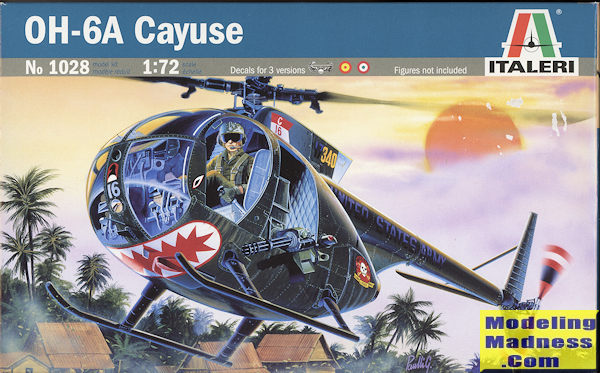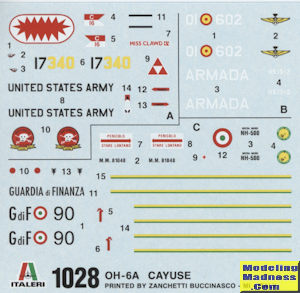
| KIT #: | 1028 |
| PRICE: | $11.00 |
| DECALS: | Three options |
| REVIEWER: | Scott Van Aken |
| NOTES: |

| HISTORY |
In 1960, the United States Army issued Technical Specification 153 for a Light Observation Helicopter (LOH) capable of fulfilling various roles: personnel transport, escort and attack missions, casualty evacuation and observation. Twelve companies took part in the competition and Hughes Tool Company's Aircraft Division submitted the Model 369. Two designs, those submitted by Fairchild-Hiller and Bell, were selected as finalists by the Army-Navy design competition board, but the U.S. Army later included the helicopter from Hughes as well.
The first Model 369 prototype flew on 27 February 1963. Originally designated as the YHO-6A according to the Army's designation system, the aircraft was redesignated as the YOH-6A in 1962 when the Department of Defense created a Joint designation system for all aircraft. Five prototypes were built, fitted with a 252 shp (188 kW) Allison T63-A-5A, and delivered to the U.S. Army at Fort Rucker, Alabama to compete against the other 10 prototype aircraft submitted by Bell and Fairchild-Hiller. During the course of the competition, the Bell submission, the YOH-4, was eliminated as being underpowered (it used the 250 shp (186 kW) T63-A-5). The bidding for the LOH contract came down to Fairchild-Hiller and Hughes. Hughes won the competition, and the Army awarded a contract for production in May 1965, with an initial order for 714 that was later increased to 1,300 with an option on another 114. Hughes's price was $19,700 per airframe, less engine, while Hiller's price was $27,000 per airframe, less engine. The Hiller design had a boosted control system, while the Hughes design did not. This would account for some of the price difference. Hughes is reported to have told Jack Real that he lost over $100 million in building 1,370 airframes. It was reported that Howard Hughes had directed his company to submit a bid at a price below the actual production cost of the helicopter in order to secure this order, resulting in substantial losses on the U.S. Army deal, with the anticipation that an extended production cycle would eventually prove financially viable.
In 1968 Hughes submitted a bid to build a further 2,700 airframes. Stanley Hiller complained to the U.S. Army that Hughes had used unethical procedures; therefore, the Army opened the contract for rebidding by all parties. Hiller did not participate in the rebidding, but Bell did, with their redesigned Model 206. After a competitive fly-off, the Army asked for sealed bids. Hughes bid $56,550 per airframe, while Bell bid $54,200. Reportedly, Hughes had consulted at the last moment with his confidant Jack Real, who recommended a bid of $53,550. Hughes, without telling him, added $3,000 to the bid and thus lost the contract.
| THE KIT |
 Italeri has built quite a reputation for doing helicopter kits, something that few other manufacturers have done. Perhaps it is the perception that they are not 'sexy' so will not sell as well as another Mustang or F-18. Whatever, it has allowed Italeri to build up quite a catalogue of kits. This one is by no means a new tool as one soon realizes from its raised panel lines and somewhat dated molding. Apparently this was originally molded in 1992 as the AH-6A and later had bits added to make it an OH-6A in 1994. Judging by the sprue layout, that is quite feasible, though I would have guessed the molding to be older than that.
Italeri has built quite a reputation for doing helicopter kits, something that few other manufacturers have done. Perhaps it is the perception that they are not 'sexy' so will not sell as well as another Mustang or F-18. Whatever, it has allowed Italeri to build up quite a catalogue of kits. This one is by no means a new tool as one soon realizes from its raised panel lines and somewhat dated molding. Apparently this was originally molded in 1992 as the AH-6A and later had bits added to make it an OH-6A in 1994. Judging by the sprue layout, that is quite feasible, though I would have guessed the molding to be older than that.
The interior is well appointed with seats, collectives, cylics and pedals. The instrument panel has raised detail. There are no belts molded on the seats. The rear section can have the ammo box for the mini-gun installed if your markings option calls for it. Transparencies on the side fit from the inside while those on the top and front fit on the outside. The left side doors are separate so could be pose d open. The left rear door would be left off if mounting the mini-gun. Skids are the short versions. The four blade main rotor is well done and looks the part. The rear boom assembly is nicely done, though one will need to be sure to take care in building this up to assure proper alignment.
d open. The left rear door would be left off if mounting the mini-gun. Skids are the short versions. The four blade main rotor is well done and looks the part. The rear boom assembly is nicely done, though one will need to be sure to take care in building this up to assure proper alignment.
Instructions are well done with three main assembly steps. The differences between the markings options are shown. THe main one is the box art helo with the shark mouth that seems to be a staple of this type. A Spanish Navy version in overall gloss dark blue is provides as is a colorful green and yellow Italian variant with the Customs Police. A nice touch is the cheat line between the green and yellow bits. The decal sheet is nicely printed and since this is a recent boxing, looks to be quite usable.
| CONCLUSIONS |
The only other early OH-6 kit of which I am aware in this scale is one by AZ Models and since I've not yet seen that one, cannot really make a qualified comparison. For sure this one has been around for quite a while as I think it was once reboxed by Testors. The end result will be a small, but nice addition to any helicopter collection.
| REFERENCES |
November 2016
Copyright ModelingMadness.com. All rights reserved.
If you would like your product reviewed fairly and fairly quickly, please contactthe editor or see other details in the
Back to the Main Page Back to the Review Index Page Back to the Previews Index Page